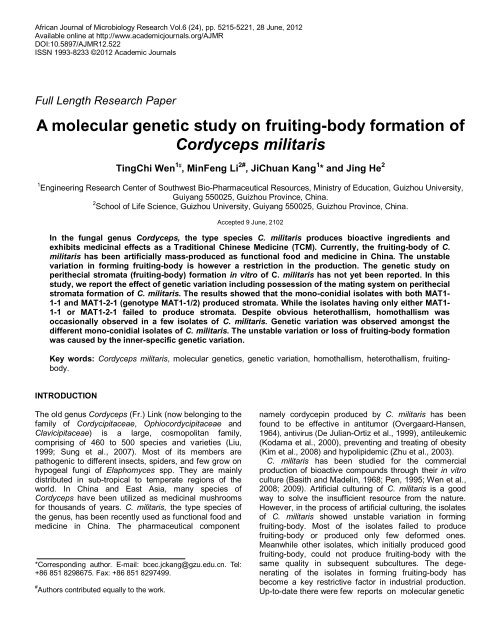Microbiology Research - Academic Journals
Microbiology Research - Academic Journals
Microbiology Research - Academic Journals
Create successful ePaper yourself
Turn your PDF publications into a flip-book with our unique Google optimized e-Paper software.
African Journal of <strong>Microbiology</strong> <strong>Research</strong> Vol.6 (24), pp. 5215-5221, 28 June, 2012<br />
Available online at http://www.academicjournals.org/AJMR<br />
DOI:10.5897/AJMR12.522<br />
ISSN 1993-8233 ©2012 <strong>Academic</strong> <strong>Journals</strong><br />
Full Length <strong>Research</strong> Paper<br />
A molecular genetic study on fruiting-body formation of<br />
Cordyceps militaris<br />
TingChi Wen 1# , MinFeng Li 2# , JiChuan Kang 1 * and Jing He 2<br />
1 Engineering <strong>Research</strong> Center of Southwest Bio-Pharmaceutical Resources, Ministry of Education, Guizhou University,<br />
Guiyang 550025, Guizhou Province, China.<br />
2 School of Life Science, Guizhou University, Guiyang 550025, Guizhou Province, China.<br />
Accepted 9 June, 2102<br />
In the fungal genus Cordyceps, the type species C. militaris produces bioactive ingredients and<br />
exhibits medicinal effects as a Traditional Chinese Medicine (TCM). Currently, the fruiting-body of C.<br />
militaris has been artificially mass-produced as functional food and medicine in China. The unstable<br />
variation in forming fruiting-body is however a restriction in the production. The genetic study on<br />
perithecial stromata (fruiting-body) formation in vitro of C. militaris has not yet been reported. In this<br />
study, we report the effect of genetic variation including possession of the mating system on perithecial<br />
stromata formation of C. militaris. The results showed that the mono-conidial isolates with both MAT1-<br />
1-1 and MAT1-2-1 (genotype MAT1-1/2) produced stromata. While the isolates having only either MAT1-<br />
1-1 or MAT1-2-1 failed to produce stromata. Despite obvious heterothallism, homothallism was<br />
occasionally observed in a few isolates of C. militaris. Genetic variation was observed amongst the<br />
different mono-conidial isolates of C. militaris. The unstable variation or loss of fruiting-body formation<br />
was caused by the inner-specific genetic variation.<br />
Key words: Cordyceps militaris, molecular genetics, genetic variation, homothallism, heterothallism, fruitingbody.<br />
INTRODUCTION<br />
The old genus Cordyceps (Fr.) Link (now belonging to the<br />
family of Cordycipitaceae, Ophiocordycipitaceae and<br />
Clavicipitaceae) is a large, cosmopolitan family,<br />
comprising of 460 to 500 species and varieties (Liu,<br />
1999; Sung et al., 2007). Most of its members are<br />
pathogenic to different insects, spiders, and few grow on<br />
hypogeal fungi of Elaphomyces spp. They are mainly<br />
distributed in sub-tropical to temperate regions of the<br />
world. In China and East Asia, many species of<br />
Cordyceps have been utilized as medicinal mushrooms<br />
for thousands of years. C. militaris, the type species of<br />
the genus, has been recently used as functional food and<br />
medicine in China. The pharmaceutical component<br />
*Corresponding author. E-mail: bcec.jckang@gzu.edu.cn. Tel:<br />
+86 851 8298675. Fax: +86 851 8297499.<br />
# Authors contributed equally to the work.<br />
namely cordycepin produced by C. militaris has been<br />
found to be effective in antitumor (Overgaard-Hansen,<br />
1964), antivirus (De Julian-Ortiz et al., 1999), antileukemic<br />
(Kodama et al., 2000), preventing and treating of obesity<br />
(Kim et al., 2008) and hypolipidemic (Zhu et al., 2003).<br />
C. militaris has been studied for the commercial<br />
production of bioactive compounds through their in vitro<br />
culture (Basith and Madelin, 1968; Pen, 1995; Wen et al.,<br />
2008; 2009). Artificial culturing of C. militaris is a good<br />
way to solve the insufficient resource from the nature.<br />
However, in the process of artificial culturing, the isolates<br />
of C. militaris showed unstable variation in forming<br />
fruiting-body. Most of the isolates failed to produce<br />
fruiting-body or produced only few deformed ones.<br />
Meanwhile other isolates, which initially produced good<br />
fruiting-body, could not produce fruiting-body with the<br />
same quality in subsequent subcultures. The degenerating<br />
of the isolates in forming fruiting-body has<br />
become a key restrictive factor in industrial production.<br />
Up-to-date there were few reports on molecular genetic

















